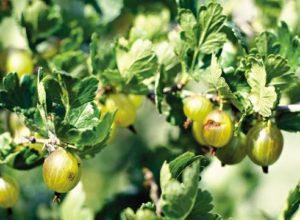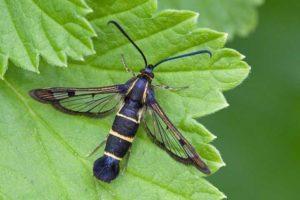Aphids on gooseberries and 5 more dangerous insects that can deprive the crop
Spring is the hottest time of the year and it's not just about the weather. Work begins in the garden and preparations for the subsequent harvest. Pests on gooseberries can pretty much spoil the crop.
Content
Gooseberry pests: who will have to face
Depending on the localization, there are different types of pests:
- those that infect the fruit;
- those that spoil green plants.
The fight against them must be carried out comprehensively and begin with agricultural technology. At the same time, it is worth making sure that the future crop is healthy and the beneficial insects are safe.
gooseberry aphid
The insect infects young petioles and shoots. Aphids suck juices, which is why growth continues, but the plant is deformed. Gooseberry shoot aphid hibernates on gooseberry branches near the buds.
leaf-eater beetle
This beetle has several names: elm, garden looper or apple leaf beetle. It is black, shiny, with a green tint. It feeds on greens, especially young leaves.
gooseberry sawfly
It may be a pale-footed or yellow subspecies. Hungry young larvae represent the greatest harm - they can eat a whole bush of foliage and even berries.
gooseberry fire
Butterflies are not harmful, but green caterpillars spread massively and quickly wrap young shoots in cobwebs. At the tips of the branches, lumps of cobwebs are obtained.
Suffer from green caterpillars and berries. They begin to rot or dry out. If you do not start the fight in a timely manner, you can lose all the berries.
Currant borer
Beetle, the main pest of currants, but often settle on gooseberries. He suffers from green parts, but the berries become smaller. Females quickly reach the age when they are ready to lay eggs.
Glassmaker
Another pest that loves both currants and gooseberries. The insect is very dangerous because it makes moves in the middle of the branches. They can live inside the shoot for more than two years and feed on juices.
If you do not remove the currant glass in a timely manner, you can lose most of the stiff and young shoots. Butterflies of this species are similar to wasps.
Preventive measures
In order not to need to use chemistry, it is necessary to carry out agricultural technology in a timely and correct manner, which will become a preventive measure.
- Cut bushes in time to remove dry shoots and larvae that hibernate on them.
- In the spring, carry out preventive spraying to avoid infection.
- Choose the right neighbors so that the plants do not become infected with harmful insects from one another.
How to deal with gooseberry pests
The simplest, but most effective ways are folk remedies. These are all kinds of decoctions and tinctures. The recipes are the same, for different types of pests, a little soap is added to each before use.
For 50 grams of dry powder, you need 5 liters of water, mix and leave for 2 days. Before spraying, mix with clean water in a ratio of 1:1.
Sift 3 kg of wood ash, mix fine powder with 10 liters of water. Insist 48 hours and spray.
Suitable potato or tomato. A bucket will require 1,5 kilograms of green mass. Leave for a day and use for spraying.
The simplest and easiest way is spraying with soapy water, it can be household, but it can be tar or green. For 10 liters of water you need 300 grams.
Chemicals
Insecticides will help to quickly destroy insects. But they can only be used in spring or late autumn, so as not to harm the crop. Biologics also have benefits, but are safe.
Insecticides:
- Karate;
- Intavir.
Biopreparation:
- Bitoxibacillin;
- Dendrobacillin.
Conclusion
Gooseberry pests can deprive gardeners of their crops. Therefore, the fight against them must be approached responsibly, starting in early spring.
Previous

